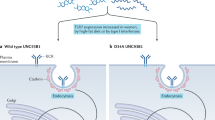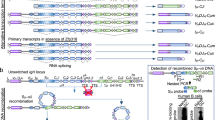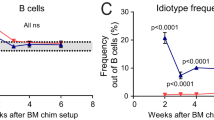Abstract
Autoreactive B cells are present in the lymphoid tissues of healthy individuals, but typically remain quiescent. When this homeostasis is perturbed, the formation of self-reactive antibodies can have serious pathological consequences. B cells expressing an antigen receptor specific for self-immunoglobulin-γ (IgG) make a class of autoantibodies known as rheumatoid factor (RF). Here we show that effective activation of RF+ B cells is mediated by IgG2a–chromatin immune complexes and requires the synergistic engagement of the antigen receptor and a member of the MyD88-dependent Toll-like receptor (TLR) family. Inhibitor studies implicate TLR9. These data establish a critical link between the innate and adaptive immune systems in the development of systemic autoimmune disease and explain the preponderance of autoantibodies reactive with nucleic acid–protein particles. The unique features of this dual-engagement pathway should facilitate the development of therapies that specifically target autoreactive B cells.
This is a preview of subscription content, access via your institution
Access options
Subscribe to this journal
Receive 51 print issues and online access
$199.00 per year
only $3.90 per issue
Buy this article
- Purchase on Springer Link
- Instant access to full article PDF
Prices may be subject to local taxes which are calculated during checkout





Similar content being viewed by others
References
Tan, E. Antinuclear antibodies: diagnostic markers for autoimmune diseases and probes for cell biology. Adv. Immunol. 44, 93–151 (1989)
Theofilopoulos, A. N. et al. Association of lpr gene with graft-vs-host disease-like syndrome. J. Exp. Med. 162, 1–18 (1985)
Wolfowicz, C. B., Sakorafas, P., Rothstein, T. L. & Marshak-Rothstein, A. Oligoclonality of rheumatoid factors arising spontaneously in lpr/lpr mice. Clin. Immunol. Immunopathol. 46, 382–395 (1988)
Shlomchik, M. J., Zharhary, D., Camper, S., Saunders, T. & Weigert, M. A rheumatoid factor transgenic mouse model for autoantibody regulation. Int. Immunol. 5, 1329–1341 (1993)
Jacobson, B. A. et al. An isotype switched and somatically mutated rheumatoid factor clone isolated from a MRL-lpr/lpr mouse exhibits limited intraclonal affinity maturation. J. Immunol. 152, 4489–4499 (1994)
Hannum, L. G., Ni, D., Haberman, A. M., Weigert, M. G. & Shlomchik, M. J. A disease-related rheumatoid factor autoantibody is not tolerized in a normal mouse: implications for the origins of autoantibodies in autoimmune disease. J. Exp. Med. 184, 1269–1278 (1996)
Wang, H. & Shlomchik, M. J. Autoantigen-specific B cell activation in Fas-deficient rheumatoid factor immunoglobulin transgenic mice. J. Exp. Med. 190, 639–649 (1999)
Rifkin, I. R. et al. Immune complexes present in the sera of autoimmune mice activate rheumatoid factor B cells. J. Immunol. 165, 1626–1633 (2000)
Emlen, W., Holers, V. M., Arend, W. P. & Kotzin, B. Regulation of nuclear antigen expression on the cell surface of human monocytes. J. Immunol. 148, 3042–3048 (1992)
Monestier, M. & Novick, K. E. Specificities and genetic characteristics of nucleosome-reactive antibodies from autoimmune mice. Mol. Immunol. 33, 89–99 (1996)
Carter, R. H., Spycher, M. O., Ng, Y. C., Hoffman, R. & Fearon, D. T. Synergistic interaction between complement receptor type 2 and membrane IgM on B lymphocytes. J. Immunol. 141, 457–463 (1988)
Ahearn, J. M. et al. Disruption of the Cr2 locus results in a reduction in B-1a cells and an impaired B cell response to T-dependent antigen. Immunity 4, 251–262 (1996)
Lemaitre, B., Nicholas, E., Michaut, L., Reichhart, J. M. & Hoffmann, J. A. The dorsoventral regulatory gene cassette spatzle/Toll/cactus controls the potent antifungal response in Drosophila adults. Cell 86, 973–983 (1996)
Medzhitov, R., Preston-Hurlburt, P. & Janeway, C. A. A human homologue of the Drosophila Toll protein signals activation of adaptive autoimmunity. Nature 388, 323–324 (1997)
Akira, S., Takeda, K. & Kaisho, T. Toll-like receptors: critical proteins linking innate and acquired immunity. Nature Immunol. 2, 675–680 (2001)
Li, M. et al. An essential role of the NF-κB/Toll-like receptor pathway in induction of inflammatory and tissue-repair gene expression by necrotic cells. J. Immunol. 166, 7128–7135 (2001)
Horng, T., Barton, G. M. & Medzhitov, R. TIRAP: an adapter molecule in the Toll signalling pathway. Nature Immunol. 2, 835–841 (2001)
Adachi, O. et al. Targeted disruption of the Myd88 gene results in loss of IL-1 and IL-18-mediated function. Immunity 9, 143–150 (1998)
Hacker, H. et al. Immune cell activation by bacterial CpG-DNA through myeloid differentiation marker 88 and tumour necrosis factor receptor-associated factor (TRAF)6. J. Exp. Med. 192, 595–600 (2000)
Singal, R. & Ginder, G. D. DNA methylation. Blood 93, 4059–4070 (1999)
Hemmi, H. et al. A Toll-like receptor recognizes bacterial DNA. Nature 408, 740–745 (2000)
Yi, A.-K. et al. CpG motifs in bacterial DNA activate leukocytes through the pH-dependent generation of reactive oxygen species. J. Immunol. 160, 4755–4761 (1998)
Hacker, H. et al. CpG-DNA-specific activation of antigen-presenting cells requires stress kinase activity and is preceded by non-specific endocytosis and endosomal maturation. EMBO J. 17, 6230–6240 (1998)
Benaroch, P. et al. How MHC class II molecules reach the endocytic pathway. EMBO J. 14, 37–49 (1995)
Massari, P. et al. Immune stimulation by neisserial porins is TLR2 and MyD88-dependent. J. Immunol. 168, 1533–1537 (2002)
The Canadian Hydroxychloroquine Study Group. A randomized study of the effect of withdrawing hydroxychloroquine sulfate in systemic lupus erythematosus. N. Engl. J. Med. 324, 150–154 (1991)
Furst, d. E. et al. Dose-loading with hydroxychloroquine improves the rate of response in early, active rheumatoid arthritis. Arthritis Rheum. 42, 357–365 (1999)
Lenart, P., Stunz, L., Yi, A.-K., Krieg, A. M. & Ashman, R. F. CpG stimulation of primary mouse B cells is blocked by inhibitory oligodeoxyribonucleotides at a site proximal to NF-κB activation. Antisense Nucleic Acid Drug Dev. 4, 247–256 (2001)
Shlomchik, M. J., Marshak-Rothstein, A., Wolfowicz, C. B., Rothstein, T. L. & Weigert, M. G. The role of clonal selection and somatic mutation in autoimmunity. Nature 328, 805–811 (1987)
Zeng, D., Lee, M.-K., Tung, J., Brendolan, A. & Strober, S. Cutting edge: A role for CD1 in the pathogenesis of Lupus in NZB/NZW mice. J. Immunol. 164, 5000–5004 (2000)
William, J., Christensen, C. & Shlomchick, M. J. Evolution of an autoantibody response is linked to somatic hypermutation outside of germinal centers. (submitted).
Botto, M. et al. Homozygous C1q deficiency causes glomerulonephritis associated with multiple apoptotic bodies. Nature Genet. 19, 56–59 (1998)
Bickerstaff, M. C. M. et al. Serum amyloid P component controls chromatin degradation and prevents antinuclear autoimmunity. Nature Med. 5, 694–697 (1999)
Napirei, M. et al. Features of systemic lupus erythematosis in DNase1-deficient mice. Nature Genet. 25, 177–180 (2000)
Scott, R. S. et al. Phagocytosis and clearance of apoptotic cells is mediated by MER. Nature 411, 207–211 (2001)
Bell, D. A., Morrison, B. & VandenBygaart, P. Immunogenic DNA-related factors. Nucleosomes spontaneously released from normal murine lymphoid cells stimulate proliferation and immunoglobulin synthesis of normal mouse lymphocytes. J. Clin. Invest. 85, 1487–1496 (1990)
Bell, D. A. & Morrison, B. The spontaneous apoptotic death of normal human lymphocytes in vitro: the release of, and immunoproliferative response to, nucleosomes in vitro. Clin. Immunol. Immunopathol. 60, 1326 (1991)
Moller, G., Andersson, J. & Sjoberg, O. Lipopolysaccharides can convert heterologous red cells into thymus-independent antigens. Cell. Immunol. 4, 416–424 (1972)
Kawai, T., Adachi, O., Ogawa, T., Takeda, K. & Akira, S. Unresponsiveness of MyD88-deficient mice to endotoxin. Immunity 11, 115–122 (1999)
Acknowledgements
We thank M. Carroll, S. Akira and D. Golenbock for providing the Cr2-deficient and MyD88-deficient mice; M. Boulé, C. Chi, C. Lau and G. Yospin for technical assistance; L. Wetzler and D. Golenbock for providing TLR ligands; H. Ploegh for providing concanamycin B; M. Fenton, L. Wetzler, R. Corley, R. Medzhitov, T. Rothstein and D. Stollar for reviewing the manuscript and/or discussions. This work was supported by grants from the National Institutes of Health, the Arthritis Foundation, and the National Kidney Foundation.
Author information
Authors and Affiliations
Ethics declarations
Competing interests
A provisional patent on the use of TLR inhibitors in the treatment of autoimmune disease.
Rights and permissions
About this article
Cite this article
Leadbetter, E., Rifkin, I., Hohlbaum, A. et al. Chromatin–IgG complexes activate B cells by dual engagement of IgM and Toll-like receptors. Nature 416, 603–607 (2002). https://doi.org/10.1038/416603a
Received:
Accepted:
Issue Date:
DOI: https://doi.org/10.1038/416603a
This article is cited by
-
Toll-like receptor 9 (TLR9) genetic variants rs187084 and rs352140 confer protection from Behcet’s disease among Iranians
BMC Rheumatology (2024)
-
Phospholipase D4 as a signature of toll-like receptor 7 or 9 signaling is expressed on blastic T-bet + B cells in systemic lupus erythematosus
Arthritis Research & Therapy (2023)
-
From risk to chronicity: evolution of autoreactive B cell and antibody responses in rheumatoid arthritis
Nature Reviews Rheumatology (2022)
-
CXCL4 synergizes with TLR8 for TBK1-IRF5 activation, epigenomic remodeling and inflammatory response in human monocytes
Nature Communications (2022)
-
Differential effects of periodontal microbiome on the rheumatoid factor induction during rheumatoid arthritis pathogenesis
Scientific Reports (2022)
Comments
By submitting a comment you agree to abide by our Terms and Community Guidelines. If you find something abusive or that does not comply with our terms or guidelines please flag it as inappropriate.



